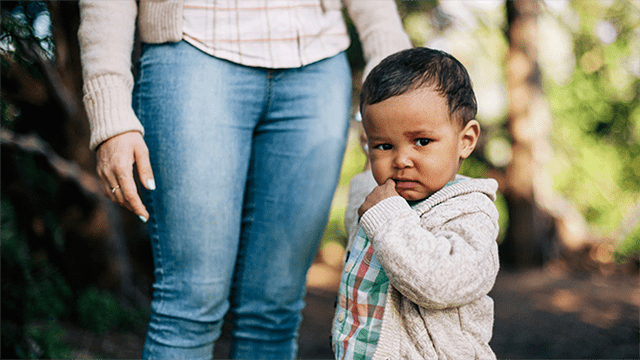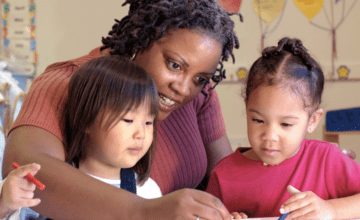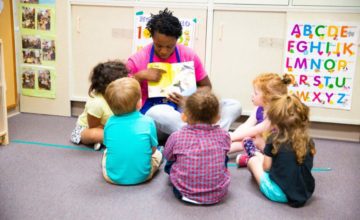Learn how to nurture your baby’s social emotional, intellectual, language, and motor development from 24 to 36 months. Explore more age ranges in our full Healthy Minds Series.
This handout is based on findings from a report From Neurons to Neighborhoods: The Science of Early Childhood Development from the National Academy of Sciences that examined child and brain development in the early years. The information we offer is age-specific, summarizes key findings from the report, and suggests how you might be able to use these key findings to nurture your own child’s healthy development.
Key Findings
Findings from the From Neurons to Neighborhoods: The Science of Early Childhood Development include:
- Your relationship with your child is the foundation of his or her healthy development.
- Your child’s development depends on both the traits he or she was born with (nature), and what he or she experiences (nurture).
- All areas of development (social, emotional, intellectual, language and motor) are linked. Each depends on, and influences, the others.
- What children experience, including how their parents respond to them, shapes their development as they adapt to the world.
How Development Looks in Everyday Life
This shows how all areas of Anthony’s development are linked and how his mother’s response encourages his healthy development.
Thirty-month-old Anthony wants to build a castle with his mom, Lena. They are almost done when Anthony begins to take it apart, block by block, and arrange the blocks in a straight line. Annoyed, Lena starts to pick up the blocks and put them back on the castle. Anthony starts to cry and tell his mom that she is not doing it right. Lena stops and asks Anthony what he is doing. Surprised that his mom isn’t “getting it,” he explains that he is building the path so the dragons can find their way to the castle. Lena smiles and watches as he completes his “dragon path.”
Anthony’s ability to play cooperatively with his mom, not just side by side, demonstrates his social and emotional development. Relationships are the foundation of a child’s healthy development.
His intellectual ability now enables him to pretend as he uses his imagination to play “castle.” Using blocks in new ways, such as building a path for his dragons, shows creativity and good problem-solving skills. He uses his language skills to clearly let Mom know what he’s thinking and planning. He uses his fine motor skills (his fingers and hands) to build the structure that he’s picturing in his mind. When Lena happily joins in Anthony’s pretend play, she makes him feel important and loved. She is flexible as she is able to put aside her annoyance and try to understand what Anthony wants to do. This lets Anthony know that he is appreciated and respected. It also leads to Lena letting Anthony direct the play, which encourages his creativity and imagination, two very important aspects of overall healthy development.
Charting Your Child’s Healthy Development
The following chart describes many of the things your baby is learning between 24 and 36 months and what you can do to support your child in all areas of her development. As you read, remember that children develop at their own pace and in their own way. Understanding who your child is, what her strengths are and where she needs more support, is essential for promoting her healthy development. If you have questions regarding your child’s development, ask your pediatrician.
| What’s going on: | What you can do: | Questions to ask yourself: |
|---|---|---|
| Two-year-olds typically can speak between 200 and 250 words. By the age of 3 years, their vocabulary is much larger still and they are able to put together 3- and 4-word sentences. | Have lots of conversations with your child. This will boost his language skills, introduce him to the pleasure of conversation and make him feel important. Also, read with your child as often as you can | What does your child like to talk about? How do you and your toddler enjoy conversations together? |
| Despite all this word power, 2-year-olds often lack the verbal skill to describe their emotions. This can leave them feeling powerless and frustrated. | Let your 2-year-old know that you understand what he’s experiencing by saying, for example, “I know you are upset that you can’t find your magic cape.” Acknowledging his feelings will help calm him and make it easier for him to tackle the challenge. | How does your child manage difficult feelings and situations? What helps him cope? |
| Play is essential for the 2-year-old. It builds all areas of his development. | Encourage pretend play and get involved. This will build a strong connection between you and your child, and can help encourage creativity. You can do this in many ways. For example, ask what will happen next in the story he is acting out. If he is “cooking,” you might say, “What are you cooking? It smells good. Can I have some?” | What kind of play does your child most enjoy? How do you know? What does this tell you about him? |
| Through play, he interacts more with friends, uses pretend play to understand things in more complex ways and learns important concepts such as big and small and up and down. | Make plans for your child to spend time with other children. He will learn about the pleasure of making friends. And the more opportunity he has to interact with peers, the more he will learn about how to get along well with others | How does your child use his imagination? What do you think he is learning through his pretend play? |
| Two-year olds are very active. | Spend time outside, where there is plenty of room to safely run, jump and climb. Visit a neighborhood park where there are other children to play with. Include your child in family sports, like swimming together or kickball. | How active is your child? Does he seem to be in constant motion or is he happy to sit and play quietly for long periods, or somewhere in between? |
| Their motor development allows them the freedom to explore in new ways as they run, jump and climb. | Create a safe place in your home where your child can actively explore. Take walks with your child and use them as opportunities to teach him important concepts such as big and small as you compare the houses on your block or the leaves on the ground. | What do you think your child is learning when he is playing actively? How do you know? |
About “From Neurons to Neighborhoods”
The report From Neurons to Neighborhoods: The Science of Early Childhood Development was a 22-year effort by a group of 17 leading professionals with backgrounds in neuroscience, psychology, child development, economics, education, pediatrics, psychiatry and public policy. They reviewed what was known about the nature of early child development and the influence of early experiences on children’s health and well-being. The study was sponsored by a number of federal agencies and private foundations.



